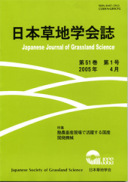Volume 25, Issue 2
Displaying 1-19 of 19 articles from this issue
- |<
- <
- 1
- >
- >|
-
Article type: Cover
1979Volume 25Issue 2 Pages Cover5-
Published: July 31, 1979
Released on J-STAGE: July 07, 2017
Download PDF (62K) -
Article type: Cover
1979Volume 25Issue 2 Pages Cover6-
Published: July 31, 1979
Released on J-STAGE: July 07, 2017
Download PDF (62K) -
Article type: Appendix
1979Volume 25Issue 2 Pages App3-
Published: July 31, 1979
Released on J-STAGE: July 07, 2017
Download PDF (43K) -
Article type: Article
1979Volume 25Issue 2 Pages 97-102
Published: July 31, 1979
Released on J-STAGE: July 07, 2017
Download PDF (600K) -
Article type: Article
1979Volume 25Issue 2 Pages 103-109
Published: July 31, 1979
Released on J-STAGE: July 07, 2017
Download PDF (825K) -
Article type: Article
1979Volume 25Issue 2 Pages 110-116
Published: July 31, 1979
Released on J-STAGE: July 07, 2017
Download PDF (767K) -
Article type: Article
1979Volume 25Issue 2 Pages 117-120
Published: July 31, 1979
Released on J-STAGE: July 07, 2017
Download PDF (410K) -
Article type: Article
1979Volume 25Issue 2 Pages 121-127
Published: July 31, 1979
Released on J-STAGE: July 07, 2017
Download PDF (656K) -
Article type: Article
1979Volume 25Issue 2 Pages 128-135
Published: July 31, 1979
Released on J-STAGE: July 07, 2017
Download PDF (813K) -
Article type: Article
1979Volume 25Issue 2 Pages 136-143
Published: July 31, 1979
Released on J-STAGE: July 07, 2017
Download PDF (709K) -
Article type: Article
1979Volume 25Issue 2 Pages 144-149
Published: July 31, 1979
Released on J-STAGE: July 07, 2017
Download PDF (623K) -
Article type: Article
1979Volume 25Issue 2 Pages 150-155
Published: July 31, 1979
Released on J-STAGE: July 07, 2017
Download PDF (625K) -
Article type: Article
1979Volume 25Issue 2 Pages 156-160
Published: July 31, 1979
Released on J-STAGE: July 07, 2017
Download PDF (501K) -
Article type: Article
1979Volume 25Issue 2 Pages 161-166
Published: July 31, 1979
Released on J-STAGE: July 07, 2017
Download PDF (752K) -
Article type: Appendix
1979Volume 25Issue 2 Pages 167-168
Published: July 31, 1979
Released on J-STAGE: July 07, 2017
Download PDF (193K) -
Article type: Appendix
1979Volume 25Issue 2 Pages 170-
Published: July 31, 1979
Released on J-STAGE: July 07, 2017
Download PDF (32K) -
Article type: Appendix
1979Volume 25Issue 2 Pages 170-
Published: July 31, 1979
Released on J-STAGE: July 07, 2017
Download PDF (32K) -
Article type: Cover
1979Volume 25Issue 2 Pages Cover7-
Published: July 31, 1979
Released on J-STAGE: July 07, 2017
Download PDF (71K) -
Article type: Cover
1979Volume 25Issue 2 Pages Cover8-
Published: July 31, 1979
Released on J-STAGE: July 07, 2017
Download PDF (71K)
- |<
- <
- 1
- >
- >|
